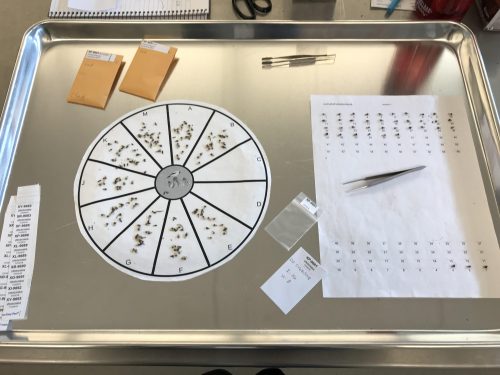On to another job of the Echinacea project!
In recent weeks, I was trained in the process of randomizing the achenes collected from each Echinacea angustifolia head. After a thorough count is taken of all achenes per head, the measurement of seed count is also preferred. For clarification, the achenes are the fruit and if they have been fertilized then they will contain a seed. We measure seed count by taking a sample size of randomized achenes from each head to eventually be X-rayed. To begin the randomization process, I was given a chart that was divided into several sections. I took one of the labeled achene envelopes and scattered the achenes evenly over each section. I then used a computer randomizing application to generate two sections from the chart containing achenes. Once I moved the randomly selected achenes onto a separate sheet, I then examined each one and decided if they were informative or uninformative. An uninformative achene would either be shredded, contain a hole – which we believe is do to some sort of critter who may enjoy the achene or seed as a snack, or a ray-floret achene. The ray-floret achenes are three sided and infertile. These achenes surround the outer circle of the E. angustifolia head and hold the ray leaves, also known as the petals. The informative achenes are four sided and may possibly contain a seed. Once I determined informative versus uninformative, I re-enveloped the achenes and labeled them accordingly. The randomized achene samples will then be re-checked for conformation of informative versus uninformative achenes and later x-rayed.
The process continues with informative lessons on accuracy and precision of an unbiased experimental design. As I continue my exposure of important aspects on the Echinacea project sequence, I eagerly look forward to lessons awaiting my discovery. 🙂
Until next time floggers,
Danielle

From left to right: dried floret, uninformative ray-floret achene (3 sided), informative achene (4 sided), uninformative achene with a whole, siding of a shredded achene, and a seed!

Randomizing setup. -Notice the the two empty sections which were randomly selected. Those achenes are found on the right-hand sheet. The informative achenes are counted at the top and will be placed in the clear bag for X-ray. The uninformative achenes are counted at the bottom and will be placed in the white envelope.

Leave a Reply